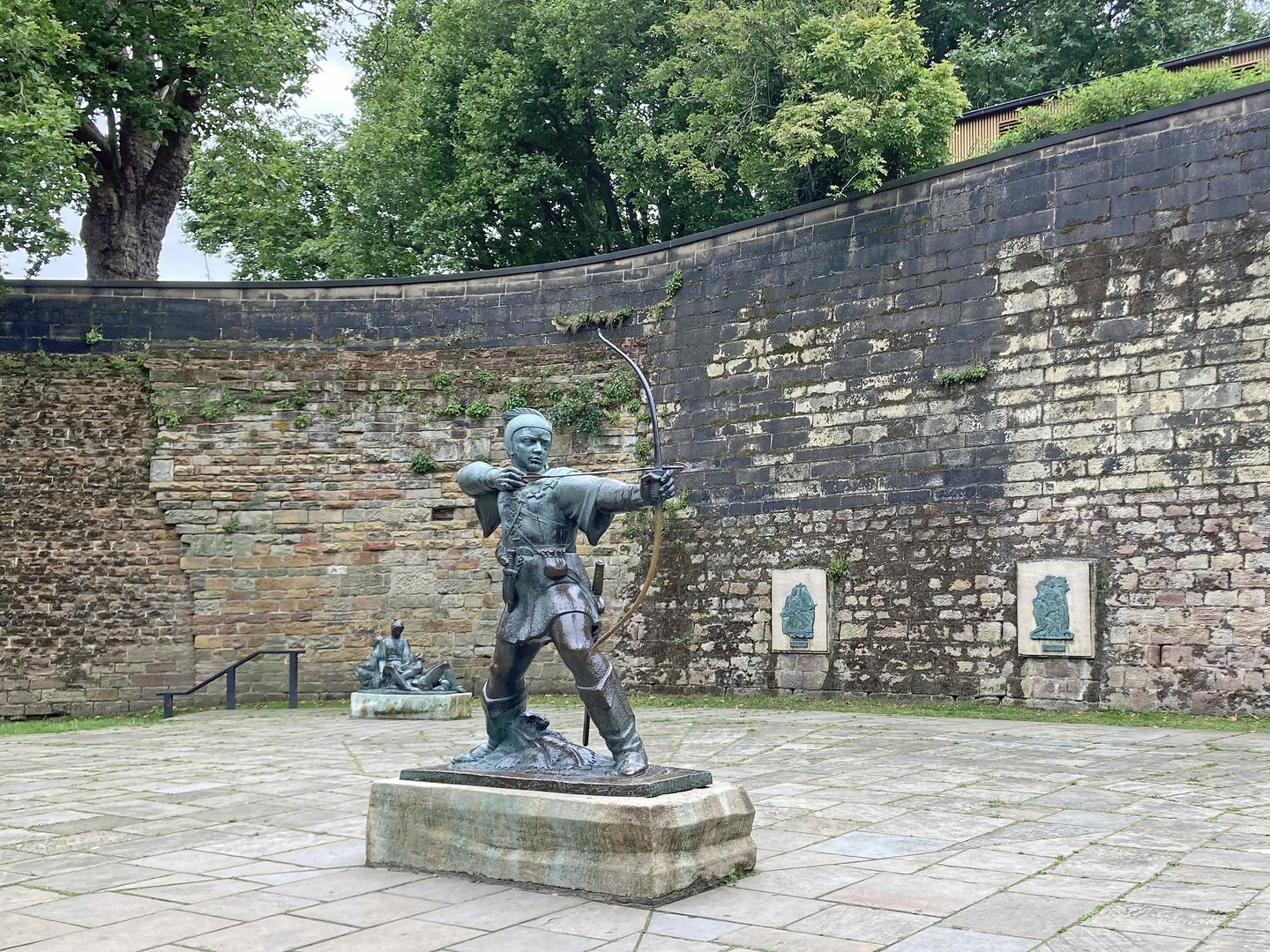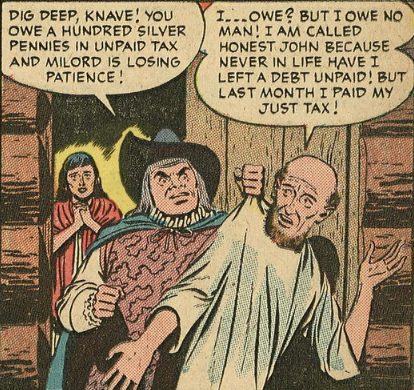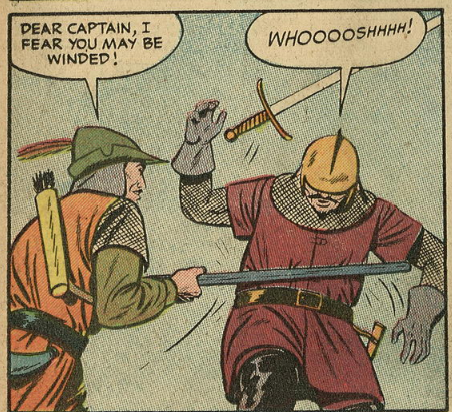
Defined by Time
Robin Hood is one of the most recognizable legends in Western culture, who is often depicted as a heroic outlaw who steals from the rich and gives to those in need. His story might seem simple: good versus evil, but his legendary status has been shaped by religious and political struggles. Historically, Robin Hood has reflected the tensions between Catholicism and Protestantism in England, molded by the English’s attitude towards faith and corruption. However, his story is not only applicable to the past. Even in modern times, Robin Hood continues to change to fit contemporary ideologies, from anti-communist perspectives in DC comics to debates over wealth redistribution and systemic religious corruption. Rather than being a static, one-sided character, Robin Hood has continuously been used as a mirror to reflect each era’s moral, political, and religious belief, showcasing how societies redefine justice, power, and rebellion in response to their fears and values.

The Religious Landscape of Medieval Era
It’s important to review the historical context of medieval England and the Protestant Reformation to understand the early religious elements within Robin Hood. Before the Reformation, the Catholic Church held immense power in England, requiring people to pay tithe, around 10% of their earnings, while the Church remained exempt from tax (History Learning Site). Alongside the vast wealth gap, many peasants also worked for free on Church land to secure a place in heaven, fueling resentment. The Protestant Reformation began in 1517 when German Monk, Martin Luther, challenged the Catholic Church’s practices. His actions were a catalyst towards a movement that eventually led to the creation of Protestantism, which emphasized a direct access to God and criticism of corrupt clergy. In England, King Henry VIII broke away from the Catholic Church, leading to a religious and political turmoil (National Geographic). All these events, during the Tudor period, shaped public perception, which influenced how figures like Robin Hood were portrayed (English Heritage).
The stories of Robin Hood have a complex relationship that reflect the religious landscape of England from the 1300s through the Reformation. In Robin Hood and the Monk, he is depicted as a Catholic figure devoted to the Virgin Mary and attending Mass, yet a monk is murdered in revenge for betraying him. At the same time, all these events occurred because Robin Hood risked his life to attend Mass and pray to the Virgin Mary in the first place, showing contradictions in his relationship with faith. His devotion is genuine, yet his willingness to use violence for justice complicates his morality, which mirrors the dilemma that many English commoners faced in an era where faith and survival were at odds. Before setting off, he gambles with Little John and refuses to repay a lost bet, despite being depicted as a righteous and God fearing person. This humanizes him, showing that he is capable of sin and making him more relatable to the common English person at the time. As Protestantism spread during the Tudor period, Robin Hood’s portrayal changed into that of an anti-clerical rebel. Monks and friars were increasingly portrayed as corrupt figures. These depictions of Robin Hood were common among the English folk, where many remained devoted to their Catholic faith but grew critical of the Church’s corruption. These ideas are also reflected in Piers Plowman, a 14th century allegorical poem critiquing the clergy’s corruption. It mirrors the same discontent seen in Robin Hood’s evolving portrayal. Just as Piers Plowman questioned whether religious institutions truly served the people, Robin Hood's character asks whether morality is defined by faith alone or by the actions one takes in the face of corruption. Robin Hood’s rebellious, and religiousness, although flawed, make him a heroic idol who is relatable with audiences because the real struggle of devotion, sin, and institutional skepticism of the Church are what many people experienced in England around this time
Robin Hood’s Justification for Wealth
In another early account of Robin Hood, A Gest of Robyn Hode, Robin Hood is once again a devout Catholic. He attends three masses in honor of the Virgin Mary and fasts since midnight. While aiding the sorrowful knight, who is indebted to the Abbot of Saint Mary’s he explicitly instructs his men to target high ranking Church officials, which reflects his opposition to the corrupt Church, and once again, the feelings of English commoners
Additionally, Robin Hood frames his acts of robbery not as crimes but as divine orders of redistribution of wealth that rightfully belong to the people. He suggests that God’s blessings are meant for the common folk, rather than being hoarded by the rich and the Church. In this way, he sees his actions are restoring a kind of divine balance. For example, Robin believes that the food from his raids is a gift from God. He declares “Tis far day; God sent us a guest; That we were at our dinner!” He means that every benefit they gain is a gift from God. He further justified his actions by dividing his winnings among the Holy Trinity and the Virgin Mary.
By doing this, he may also reflect the idea that people should have a direct relationship with God. Possibly in his view, true access to God’s blessing doesn’t come through the complex system and control of the Catholic Church but directly from God himself. This viewpoint aligns with the rise of Protestantism, which emphasizes a more direct access to God, once again reflecting the views of an English commoner.
Fun Fact
Robin Hood as a Political Symbol
Beyond religious frustrations, Robin Hood was used as a political symbol. In the 1640 parliamentary elections a political group known as the ‘The Robins’ arose, with their candidate, Alexander Popham, who adopted the name ‘Robin Hood’. Popham was a Puritan and outlawed due to debt, thus appropriately named Robin Hood. Popham lost the election, but his supporters aligned themselves with the parliament in the ensuing English Civil War. Robin Hood was actively used in political settings, which reflected the Puritans ongoing belief of Protestant Reformation (Underdown 135).

Robin Hood in the Cold War Era
Even in our modern times, Robin Hood has been remolded to fit our ideological conflict. In the 1950s, during the peak of the Red Scare, DC Comics adapted the legend of Robin Hood as a response to America’s fear of communism. The Red Scare was a period of intense anti-communist belief in the United States, further amplified by Cold War tensions. In this context, Robin Hood was framed as a symbol of resistance against authoritarianism, but instead of fighting corrupt medieval officials, he was implicitly resisting Soviet Union totalitarianism.

The Sheriff of Nottingham now became a figure for totalitarianism, taking characteristics of an oppressive ruler enforcing unjust laws, which reinforced the oppressive perception of the Soviet Union as a tyrannical enemy. Even the concept of taxation possibly took on a new meaning. Past versions portrayed taxation as a tool of corrupt nobles and clergy, while DC Comics emphasized the dangers of forced economic redistribution. In a climate where communism was associated with state controlled economics and loss of personal wealth, tax collection by the kingdom could’ve possibly served as a warning against government overreach.

Just like how earlier versions of the legend had been used to challenge religious corruption in medieval England, the DC comic adaption positioned Robin Hood as an hero of anti-communist resistance. By helping the poor against the authoritarian regime, he indirectly reinforced the American ideals of liberty and rebellion against tyranny. In doing so, Robin Hood’s legend was once again repurposed to ensure that Robin Hood remains relevant to reflect fears and political struggles of the current era, proving that his story serves as a mirror of society’s conflicts.
Mirror of Society
Whether it is the Tudor or Cold War period, Robin Hood’s status has never remained stationary. Robin Hood’s legend has been constantly used to reflect the morality, authority, and justice of different societies. Originally written as a devout Catholic man fighting against corruption, he became a figure of Protestant era resistance. Later, his name was used by Puritans to justify their fight against the monarchy and the Church, and in the 20th century, DC comics transformed him into an anti-authoritarian hero who stood against Soviet Union tyranny. Even today, Robin Hood’s name is still brought up to discuss economic inequality and governmental issues, which proves his legacy still lives on. As long as societies grapple with power and corruption, Robin Hood symbol will remain. He might change forms but will never fade from relevance.



